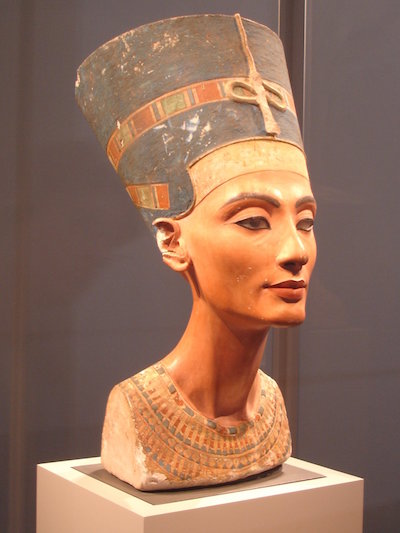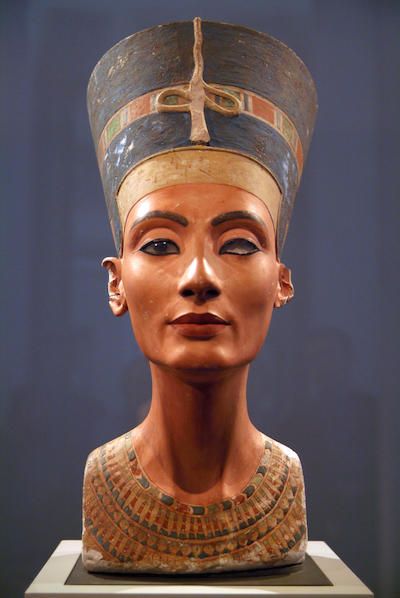The bust of Queen Nefertiti is one of the most famous pieces of ancient art, and arguably one of the most beautiful. It was crafted by the Chief Sculptor of Akhenaten, Tuthmose. It was discovered in the workshop attached to his house in Akhetaten (Amarna).
It is formed from limestone coated in layers of panted stucco. Only one of the quartz inlaid eyes remains, but other than that it is in remarkably good condition. The bust does not bear a name, but the identity of its subject is not really in doubt because of the presence of the blue crown with which Nefertiti was so closely associated.

The reign of Akhenaten and Nefertiti is characterised by a shift away from the traditional models, including a rejection of the national god Amun and the construction of a new capital dedicated to the Aten at Akhetaten. This change found expression in the exaggerated and fluid forms of Amarna Art. However, the bust of Nefertiti conforms to the classical Egyptian style.
Tuthmoses would certainly not go against the wishes of his patron, so this was clearly intended. Yet, it was found with numerous other fragments of faces, busts and statuettes, prompting Egyptologists to suggest that the bust was either a modello (to be used as a template for official portraits) or a model to allow Tuthmoses to prove his skill to potential clients. Tuthmosis would have had to move his studio to Thebes when Akhetaten was abandoned, leaving behind anything he considered worthless – including the bust of Nefertiti!
The bust of Nefertiti has an enigmatic quality which has engendered much speculation. It is perfectly symmetrical, a vision of preternatural beauty, prompting Camille Paglia to comment the proper response to the Nefertiti bust is fear. However, a CT scan of the bust confirmed that under the stucco lies a more realistic depiction of the queen, with less prominent cheekbones, a bump on the nose and wrinkles.
This raises a fascinating possibility. Did Tuthmoses plan from the outset to use his prodigious skill to create a bust of a beautiful, but imperfect woman and then hide it under a mask of divine and unattainable beauty? The observer cannot know that beneath the flawless complexion and perfect symmetry there lies a real woman, but that was perhaps the point. If so, why was the bust abandoned?
The mystery does not stop there. Because of its light complexion, her name (The beautiful one has come), and her supposedly un-Egyptian appearance it has been proposed by some that Nefertiti was of foreign birth. Proponents of this view generally consider that she was either Tadukhepa, the daughter of Tushratta the King of Mitanni, or a princess from a Mediterranean culture such as the Minoans. However, most Egyptologists now agree that she was Egyptian, although her parentage remains obscure and unconfirmed.
We know that her wet nurse was the wife of Ay, but he does not claim to be her father. We know almost nothing about her death. Some have suggested that she became pharaoh under the name of Neferneferuaten, others that she died in disgrace. To some, she is the “Elder Lady” found in Tomb KV55, while others hope her tomb is still to be found.

The bust was discovered by the German team, led by Ludwig Borchardt, who were excavating Amarna in 1912/13. At that time artefacts uncovered in Egypt were subject to partage – a system where the finds were shared between the foreign excavators (who provided the expertise and money to fund the works) and the Egyptian state. Egypt retained the right to veto the removal of specific items, but Borchardt allegedly described the piece as a gypsum bust of a princess and showed officials only a substandard photo of it. It does seem highly unlikely that had any Egyptian officials seen the bust they would have been happy to let it go. Unfortunately, Gustave Lefebvre (who had the job of assigning finds) did not leave any record of his decisions regarding the bust, or if he did they have been lost.
The bust of Nefertiti was transported to Berlin to the home of Dr James Simon (who financed the dig) and another unfinished quartzite bust stayed in Egypt. While most of the pieces from that expedition went on display in the Egyptian Museum in Berlin, the bust of Nefertiti made only a brief appearance at the opening of the exhibition. Museum records suggest that Borchardt feared the Egyptian authorities would demand the return of the bust – prompting some to conclude that he knew its removal from Egypt had not been entirely above board.
The bust of Nefertiti finally went on display in the Berlin National Museum in 1923, to the great dismay of Egyptian authorities. Negotiations to repatriate the bust commenced in 1924 under the watchful eye of Pierre Lacau, Director of the Egyptian Antiquities service, to no avail. In 1929 the Egyptian Government made an unsuccessful bid to swap the bust of Nefertiti for a selection of other beautiful pieces, but they were turned down. Six years later the Prussian Prime Minister, Hermann Goring, agreed to send Nefertiti home but he was overruled by Adolf Hitler. Hitler approved of Nefertiti’s supposedly Aryan features and planned to make the bust one of the main attractions in the Museum of Germania (his new name for Berlin in its role as the capital of the world).
When Berlin was partitioned following the Second World War, the bust of Nefertiti stayed in West Berlin and became an unofficial cultural symbol of the city. However, Egyptian authorities have not given up hope. Following repeated unsuccessful requests for its repatriation they appealed to UNESCO to arbitrate in 2005, unsuccessfully.
In recent years Dr Zahi Hawas has threatened to ban exhibitions of Egyptian antiquities in Germany, tried to organise a boycott of loans to German museums and suggested a deal whereby Egypt and Germany could share the bust to the benefit of each party. German authorities have rejected any suggestion that the bust of Nefertiti was removed from Egypt illegally and claim that the bust is too fragile to be moved.
In 2016 two artists covertly scanned the bust and printed a 3D replica which they donated to Cairo Museum in an act of protest over the high number of Egyptian artefacts housed in museums outside Egypt.
Bibliography
- Dijk, Jacobus Van (2000) “The Amarna Period and the later New Kingdom”, in The Oxford History of Ancient Egypt Ed I. Shaw
- Fletcher, Joann (2004) The search for Nefertiti
- Kemp, Barry (2015) The City of Akhenaten and Nefertiti, Amarna and its people
- Silverman, Helaine (2010) Contested Cultural Heritage: Religion, Nationalism, Erasure, and Exclusion
- Tyldesley, Joyce (1998) Nefertiti
Copyright J Hill 2017